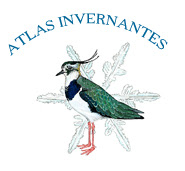I have finished the tracks that I have made for the Atlas of wintering birds, project in phase of test of the SEO/BirdLife.
The grid that I have selected, to be one of the same ones that I have for the accomplishment of SACRE and NOCTUA.
This zone, although is very interesting biologically, is a zone very difficult to take a census, since the habitats are varied and the displacements between and others have been enough time, as well as the effort that supposes the accomplishment of some tracks, with strong unevennesses.
The geographic position and the altitude above sea level, by these two factors, this zone tends to be of great atmospheric variability, and in winter with enough difficulty to find days adapted for the accomplishment of the censuses, if it is not raining or snowing (very probably), it is cleared, with which the mornings appear with heavy frost and mist.
Even so, the census has been productive, although I to miss some species that usually are present other years, possibly due to the high temperatures at the beginning of the winter.
I have located 41 different species, the most located Common Chafinch (Fringilla coelebs) the Great Tit (Parus major) and Jay (Garrulus glandarius).
The grid that I have selected, to be one of the same ones that I have for the accomplishment of SACRE and NOCTUA.
This zone, although is very interesting biologically, is a zone very difficult to take a census, since the habitats are varied and the displacements between and others have been enough time, as well as the effort that supposes the accomplishment of some tracks, with strong unevennesses.
The geographic position and the altitude above sea level, by these two factors, this zone tends to be of great atmospheric variability, and in winter with enough difficulty to find days adapted for the accomplishment of the censuses, if it is not raining or snowing (very probably), it is cleared, with which the mornings appear with heavy frost and mist.
Even so, the census has been productive, although I to miss some species that usually are present other years, possibly due to the high temperatures at the beginning of the winter.
I have located 41 different species, the most located Common Chafinch (Fringilla coelebs) the Great Tit (Parus major) and Jay (Garrulus glandarius).
Also Common Chafinch (Fringilla coelebs) has been most abundant, I have seen flocks of more than 100 birds.





